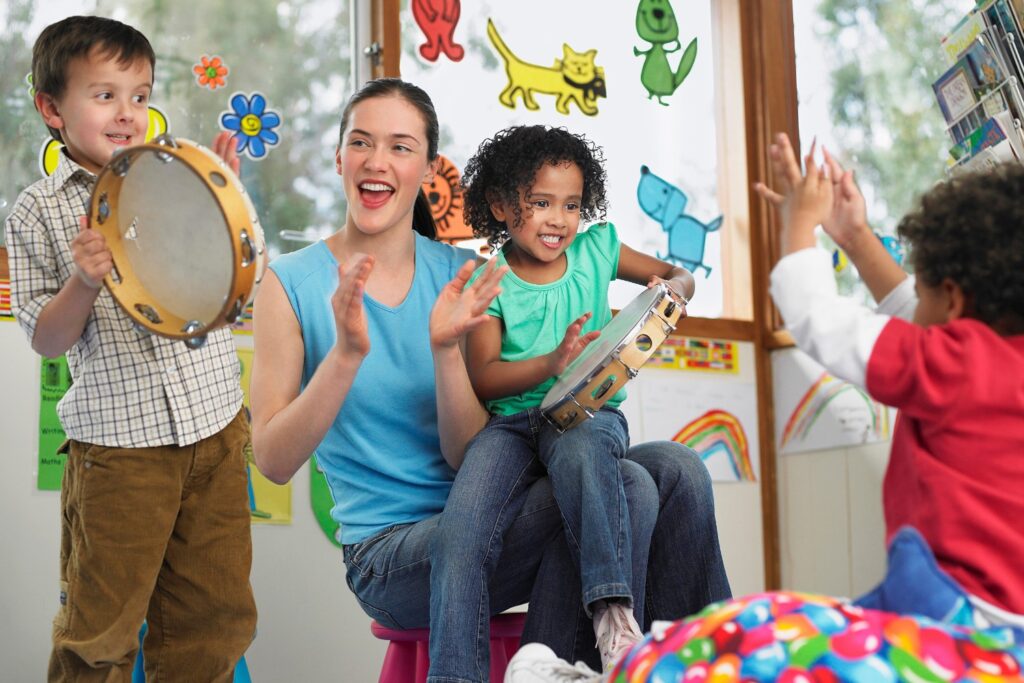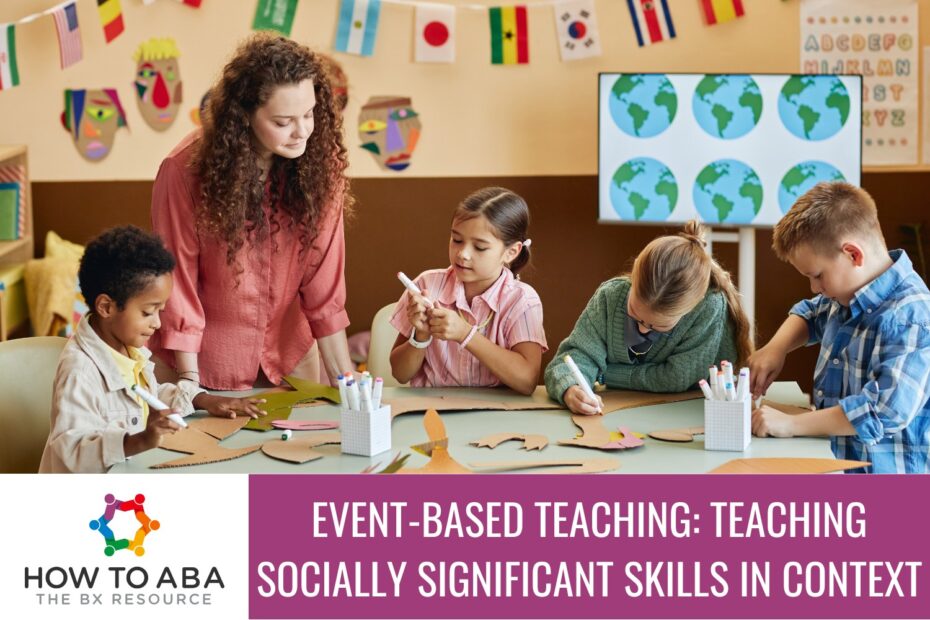When it comes to Applied Behavior Analysis, one of the most powerful ways to teach is by connecting learning directly to real-life experiences. This is where event-based teaching comes in. Rather than isolating skills in artificial practice drills, event-based teaching focuses on embedding instruction into meaningful activities that matter to the learner.
At its core, this approach makes teaching more natural, engaging, and effective – helping individuals not only learn new skills but also apply them where it counts: in everyday life.
What is Event-based Teaching?
Event-based teaching is a powerful way to build instruction directly into a learner’s day. Forget flashcards and isolated drills for a moment. Instead, think about a meaningful, real-life activity that happens frequently and is made up of many smaller steps. That entire activity is what we call an “event.”
An event could be something as simple as the morning routine, getting ready for school, or preparing a snack. The goal is to take these recurring routines and transform them into rich learning opportunities. We do this by “stacking” multiple skills together within the natural flow of the activity. Best of all, the reinforcement is embedded right into the process – the successful completion of the task is the reward.
This approach is particularly effective for certain learners, such as those who:
- Have a limited verbal repertoire
- Struggle with generalizing skills from the therapy room to the real world
- Learn best through direct, hands-on experience with natural consequences (contingencies)
For these individuals, learning in context is a game-changer. By teaching skills in the exact environment where they will be used, we connect the dots for them in a concrete way.
For example, during the “making a sandwich” event, a learner isn’t just practicing one skill. They might be following multi-step directions, requesting ingredients, using utensils, and then enjoying the sandwich they made. The learning is tangible, functional, and immediately applicable, which is exactly what makes event-based teaching so impactful.
Are you a BCBA who loves your work but struggles with feeling overwhelmed, under pressure, and in need of REAL support?

We get it, and we’ve been there too.
As fellow BCBAs, we know how overwhelming it can be to take care of ourselves and the families we serve.
We created The Bx Resource as a way to unite and support fellow ABA professionals. By sharing our materials, guidance, and resources, we can help save you time and energy so that you can feel confident in the work you love!
Become a Pro Member
Why Does Context Matter?
Have you ever seen a learner perfectly master a skill in a therapy session, only for that skill to seemingly vanish the moment they’re at home or in the community? It’s a common and often frustrating experience for practitioners and families alike. The issue isn’t that the learning didn’t happen; it’s that it didn’t generalize to where it truly counts.
This is where event-based teaching shines. It closes that gap by focusing on essential skills that directly boost a learner’s independence within their own community and culture. Instead of teaching skills in isolation, this approach ties them to meaningful, real-life events.
When a learner practices requesting an item during a real snack time or works on social greetings at an actual family gathering, the skill becomes relevant and functional. The context provides the “why” behind the learning, making it far more likely to stick. This method moves beyond rote memorization, building a bridge between the therapy room and the real world, which is the ultimate goal for fostering genuine independence.
The Benefits of Event-Based Teaching
Event-based teaching offers benefits not only for learners but also for families, teachers, and therapists:
- Better generalization: Learners apply skills across different settings and people.
- Higher motivation: Learning feels purposeful because it happens in the context of meaningful activities.
- Stronger relationships: Skills like communication and cooperation are practiced in real social interactions.
- Long-term independence: Learners develop habits that carry over into daily life without needing constant prompts.
Which skills should you include? The Behavioral Health Index is a great way to measure which skills to work on.

Social Significance: More Than Just Skills
In ABA, we talk a lot about “socially significant skills.” These are skills that make a real difference in someone’s life, like:
- Communicating wants and needs
- Building friendships
- Following safety routines
- Managing daily self-care tasks
- Making choices and advocating for oneself
Event-based teaching is especially powerful for teaching these skills. Because they’re woven into meaningful activities, learners get to practice them naturally, not as abstract exercises. For example, learning to politely decline food is much more relevant at a family dinner than during a role-play with pretend snacks.
How Event-Based Teaching Works
Here’s how professionals and caregivers can start applying this approach:
1. Identify Natural Opportunities
Think about the learner’s daily schedule, routines, and upcoming events. Each one holds countless chances for teaching. Morning routines, classroom group work, mealtimes, playdates, and even errands like grocery shopping all offer natural learning opportunities.
2. Match Skills to Contexts
Once you’ve identified the opportunities, decide which skills fit best. For example:
- Grocery shopping: labeling foods, making choices, handling money, waiting in line.
- Birthday parties: social greetings, sharing, joint attention, and conversation skills.
- Household chores: following instructions, sequencing, problem solving.
3. Keep It Natural
The goal isn’t to interrupt events with rigid teaching moments. Instead, embed prompts and reinforcement within the flow of the activity. If the learner forgets to say “thank you” when given a toy, you might gently prompt them in the moment, then fade back to let the natural interaction take over.
4. Reinforce Success
Positive reinforcement is essential. Whether it’s verbal praise, access to a preferred item, or natural reinforcement (like more playtime with a friend), celebrating success makes the skill more likely to stick.
5. Collaborate with Families and Teachers
Event-based teaching doesn’t happen in isolation. Caregivers, teachers, and therapists should communicate regularly about the skills being targeted and how to support them in various settings.
Are you a BCBA who loves your work but struggles with feeling overwhelmed, under pressure, and in need of REAL support?

We get it, and we’ve been there too.
As fellow BCBAs, we know how overwhelming it can be to take care of ourselves and the families we serve.
We created The Bx Resource as a way to unite and support fellow ABA professionals. By sharing our materials, guidance, and resources, we can help save you time and energy so that you can feel confident in the work you love!
Become a Pro Member
Event-based Teaching Examples in Action
Now that we understand why context is so important, let’s look at how this plays out in real-world activities. (The key is to remember that the focus isn’t on the final product; it’s about the valuable skills practiced repeatedly within the routine.)
Take an activity like baking cookies, for example. It might seem like it’s just about making a sweet treat, but this “event” is packed with learning opportunities. Within this single routine, a learner can practice:
- Following multi-step directions from a recipe.
- Requesting ingredients or tools (“more flour,” “I need the spoon”).
- Measuring ingredients, which works on fine motor skills and numeracy.
- Waiting patiently while the cookies are in the oven.
The best part? The reinforcement is built right in. The natural reward is getting to enjoy the delicious cookies they helped create, making the entire learning process both meaningful and motivating.
Similarly, a craft project, like making a paper collage, offers a wealth of chances for skill-building. It’s not about creating a museum-worthy piece of art; it’s about the process. During this event, a learner can work on:
- Making choices by selecting different colors of paper or types of glue.
- Practicing fine motor skills through cutting with scissors and pasting.
- Requesting help when a step is difficult.
- Commenting on their creation (“I made a blue circle”).
In both scenarios, the activity provides a natural and repeatable structure for practicing essential skills. By focusing on the smaller steps within these fun events, we help learners build a foundation of functional abilities that they can use every day.
Event-based teaching isn’t about discarding structured teaching altogether – it’s about striking the right balance. Discrete trials and structured learning still have their place in ABA, especially for teaching new concepts. But once a skill is emerging, weaving it into real-life events helps it take root.
By teaching socially significant skills in context, we give learners more than just knowledge – we give them the tools to connect, participate, and thrive in their everyday lives.

